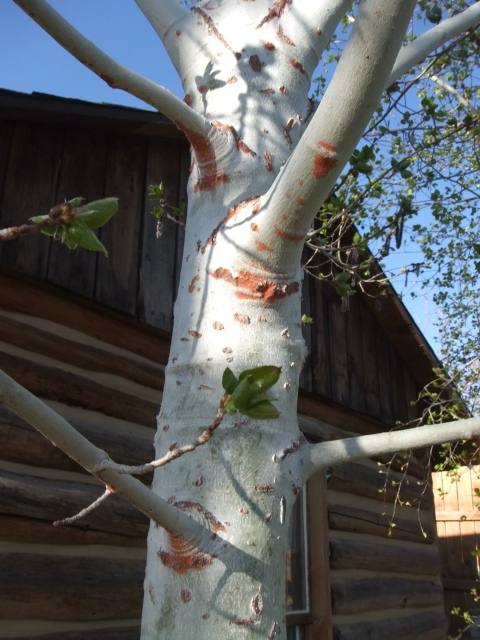Question
 aspen
aspen
I have three aspens planted together appx age 8 yrs. This is the first spring I noticed a rusty powder from botttom to tops of trees: at the base of limbs, on trunk, in scratches, etc. It wipes off. Our elevation is appx 5,300. The trees are just beginning to leaf. We have had a very cold, snowy winter. Should I be concerned?
AnswerThis is a canker disease called Cytospora canker.
In disease affects already weakened or stressed trees, and the fungus usually gains entry through a wound on the branches or trunk. After the infection is initiated, part of the bark dies and a true canker may form in rare cases. In wet weather, the fungal spores are discharged from the bark in hair like, orangey coils; they are then disseminated by rain, wind and animals.
The disease appears as sunken, dead areas of brown bark, around an entry point of infection, generally a wound or dead twig. Under the bark, the wood is discoloured and wet and has an unpleasant odour. Orange fruiting bodies and occasionally orange tendrils (conidia) protruding through the bark can also be seen. This disease is rarely a problem of economic importance in natural stands, but can cause serious damage in forest nurseries, young plantations, and in horticultural settings.The initial infection is followed by the death of part of the bark and rarely by the formation of a true canker. In humid weather, the spores of the fungus are released from the bark in the form of orange tendrils and are spread by rain, wind or animals.
Cytospora chrysosperma has been shown to inhabit healthy bark of aspen and beech, causing disease only in trees or branches of low vigour or when the hosts are stressed by drought, injury, sunscald, fire, or other pathological disorders. The presence of this disease generally indicates that the trees are under stress.
Once infection occurs, the best treatment is to increase plant vigor and sanitation. Remove all infected limbs and other areas. When removing branches, make a smooth cut at the base of the limb, as near the trunk as possible, without damaging the branch collar (swollen area at base of branch). Jagged and rough cut surfaces promote infection.
Clean wounds to avoid further spread of infection. Remove dead bark to dry out the diseased area and help the tree defend itself against insect and fungal attacks on the cankered area. Directions for proper wound and canker treatment are as follows:
Prune or cut trees only during dry weather.
Clean tools and wipe them with ethyl alcohol, Lysol or other disinfectant. Clorox may be used at a concentration of one part Clorox to nine parts water.
If a wound is fresh (one month old or less), use a sharp knife to carefully cut and remove all injured or diseased bark back to live, healthy tissue. If the wound is older, just remove loose bark pieces. It is important not to cut, remove or damage callus that may be forming at the canker edge. Callus will look like swollen bark growing across the dead area. Scrape the wound surface clean of loose bark.
Clean tools and disinfect after each cut.
Cleaned wounds should not have any sharp angles.
Do not apply any tar, oil-based paint or other wound dressing. The best method to prevent infection or decay is to allow the cleaned tissue to dry out.
I would also fertilize the tree with 10-10-10 fertilizer at the rate of 1 lb per inch of trunk Diameter scattered around the tree and watered in good. Apply just before a rain storm and you will not need to water.






